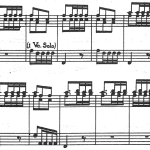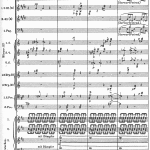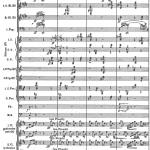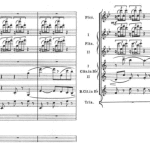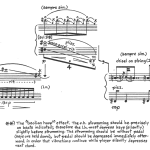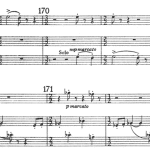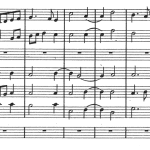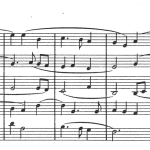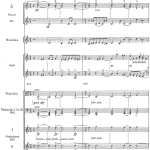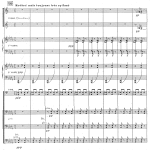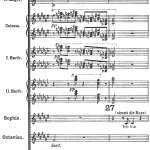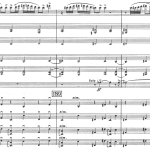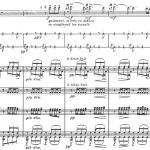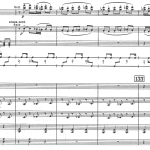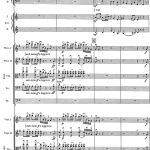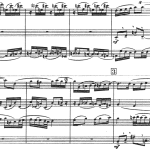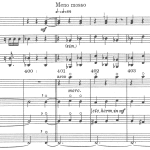Previously, terms such as imitation, echo and analogy have been used to describe similarities between sounds. Because of the overwhelming richness of tone colors and sound combinations of the modern orchestra, imitation in the broadest sense has become a central part of its idiomatic repertoire. This may be orchestral imitation of specific overtone spectra[1] or instrumental tone colors, the piano’s sustain pedal, acoustic reflection or echo, etc. Or, for example, sounds from the environment or sounds that appear to come from far away.
The term imitation – to mimic something – may have a negative ring to it, but here it is used as a neutral term describing the intentional use of similarities. For the experienced, discerning orchestrator, the word is actually a hallmark: the ability to imitate any acoustic phenomenon by using the possibilities offered by the orchestra is in itself proof of having mastered the medium. Strauss claimed that one must be able to “orchestrate a dinner party so that the difference between knives and forks can be heard.”
The idea of imitation can stimulate the imagination in special ways. Many pianists gladly admit to using the sounds of the orchestra as an imaginary background to accomplish the right sonority, character and touch in certain passages. In the course of history, composers with highly developed imaginations and a refined ear have been similarly stimulated by sound imitation, something that often has led to innovative effects. Below a series of famous and striking examples.
The solo violin imitating a hunting horn in Vivaldi’s “Autumn” (from The Four Seasons) still has an astounding effect after nearly 300 years.
Figure 146 · Vivaldi, The Four Seasons, “Autumn,” 3rd movement, m. 30
Strauss’ imitation of a bleating flock of sheep in Don Quixote – first calm, then agitated – is a gem, of course.
Figure 147 · Strauss, Don Quixote, Variation II, m. 224
Figure 148 · Strauss, Don Quixote, Variation II, m. 234
The same is true of Stravinsky’s razor-sharp imitation of a creaking barrel organ in Petrushka.
Figure 149 · Stravinsky, Petrushka, number 22
In his chamber piece Vox Balaenae (Voice of the Whale), George Crumb ingeniously imitates the sound of a distant seagull with a cello that plays a technically sophisticated, repeated glissando in harmonics.
Figure 150 · Crumb, Vox Balaenae (1971), “Archeozoic,” m. 1
If such examples are too unique to develop further – and the list is virtually endless! – it must be this unique sensitivity to sounds that again and again allows composers to discover similarities and acoustic analogies where they are not immediately evident.
In his Symphony in Three Movements, Stravinsky reveals a baffling similarity between staccato notes played in the same register of piano and trombone.
Figure 151 · Stravinsky, Symphony in three Movements, 3rd movement, number 169, m. 5
In his baroque pastiche, the theater music to Molière’s Der Bürger als Edelmann, Strauss exploits the lowest register of the piccolo flute in a way that makes it difficult to distinguish from a recorder (Strauss gave no practical indication of how the instrument is supposed to play the low C).
Figure 152 · Strauss, Der Bürger als Edelmann, 7th movement, m. 46
In the same work, Strauss imitates the sound of baroque viols spot on.
Figure 153 · Strauss, Der Bürger als Edelmann, 7th movement, m. 1
And Stravinsky imitates the sound of renaissance instruments in his ballet Agon with great sophistication.
Figure 154 · Stravinsky, Agon, Gailliarde, m. 164
In “Fêtes,” from Trois nocturnes, Debussy seems to introduce a “virtual” guitar by means of string pizzicati, harp and kettledrum.
Figure 155 · Debussy, Nocturnes, “Fêtes,” number 10
A deservedly famous, innovative, “silvery” sound combination results from the instrumentation of descending chords that form a leitmotif when the silver rose is presented in Strauss’ Rosenkavalier.
Figure 156 · Strauss, Der Rosenkavalier, 2nd Act, number 26, m. 5
At times, not least in Mahler and Stravinsky, but also in Debussy, two or more clarinets in the high or highest register are used in perfect unison. The very characteristic, stridently penetrating sound (recalling the fact that etymologically “clarinet” means “little trumpet”) is very impressive when used with clear intent.
Figure 157 · Stravinsky, Petrushka, “Dance of the Peasant and the Bear,” number 188, m. 3
Figure 158 · Debussy, Iberia, number 57, m. 4
The use of acoustic analogies has become a part of standard orchestral practice. The previously mentioned similarity between horns and bassoons in the middle register is often used to achieve a “slimmer,” more focused sound that still retains its horn-like qualities.
Figure 159 · Stravinsky, Petrushka, number 132, m. 3
Figure 160 · Stravinsky, Pulcinella, 1st movement, number 5, m. 5
Other doublings or mixtures based on acoustic similarities have become standard, if not to say textbook material. To mention only some of the most popular: low clarinet and viola, horn and cello (or all horns and all low strings), oboes and trumpets at soft dynamics, bassoons and string pizzicato. Not quite as well known are the timbral similarities between a bassoon in the high register, an alto saxophone, and a trumpet with cup mute. And the fact that some brass instruments with mutes in certain registers can be difficult to distinguish from woodwinds in the same (or a different) register is a standing invitation to listen to sounds without prejudice. This, however, is an area that will not be examined further here, as the existing literature on instrumentation provides an abundance of examples. A special literary niche on the subject even offers endless tables listing “well-sounding” instrumental combinations, doubling strategies, etc. – an ambitious attempt at systematization that only too rarely has proved to be useful in practice. The intention here is merely to stimulate the interest in locating and studying particularly fascinating sound combinations in the orchestral literature, or indeed wherever they may be found.
The modern synthesizer now offers composers the opportunity to listen to his or her music while composing it, among other things thanks to the increasing availability of realistic digital copies (samples) of existing instruments. Whether this will generally weaken the composer’s imagination, the ability to invent entirely new instrumental sound textures solely by using mental resources and the inner ear, is unclear (but allegedly it has been demonstrated that children who habitually use pocket calculators are less able to rely on mental arithmetic).
No matter what, there is much reason to admire the highly developed ability of composers past and present to imagine and mix instrumental colors. And it should be stressed again that this skill is based on a profound knowledge of the sound of all instruments in all registers, as well as insight, be it theoretical or intuitive, into the relative volume or “amplitude” of overtones in an instrumental sound. The study of such spectra, which vary from register to register, at times even from tone to tone, is a must for anyone who wants to refine their ability as an orchestrator without necessarily possessing the intuition of a genius.
A few examples will further corroborate the significance of such insight (the subject has been touched upon earlier, see for example figure 44 and figure 45).
The overtone spectrum of a flute reveals that the first overtone (octave) is powerfully present. This gives the instrument a sinus-like tone quality and thus the particular ability to act as an “artificial” overtone or to amplify an overtone not distinctly present in other instruments (cf. figure 44).
A predilection for using the flute to double two octaves above the fundamental (i.e. the third overtone), notably with a clarinet or a bassoon playing the fundamental, goes back to the classical period, not least Mozart, and nearly became a trademark for Sibelius. In spite of the high register, flute doubling increases the fullness of sound without becoming overly prominent in itself. Other spectra with few or weak overtones are string harmonics, the weak “filling in” tones of the clarinet’s middle register (written G4, G#4, A4, A#4), alternative fingerings in woodwinds, so-called “overblowing” by using a fundamental other than the one usually used (indicated with a tiny circle above the note) and the celesta (cf. the “mixture” by Ravel, figure 45).
When formants appear as powerful and high-pitched peaks or “clusters” in the sound spectrum, the result is in an intense and often penetrating sound. Examples can among others be found in the oboe, in sharp-sounding muted brass (particularly at strong dynamic levels), stopped horn, clarinets in the low chalumeau register, the G-string of the violin and the A-string of the cello, low double bassoon and to some extent also low bassoon. High formants are usually audible as a kind of “hiss” in the sound, something entirely absent in the tone of the flute or in string harmonics. Ravel’s Bolero is a virtual textbook on overtone spectra and sound intensity. The reason behind Ravel’s carefully chosen order of solo instruments in the first part of the piece is a step-by-step increase in intensity (which is why the oboe with its intense sound must resign itself to not being used as a solo instrument, cf. Parallel Doubling).
Sul ponticello in the strings (or près de la table on the harp) results in high, powerful formants that can be modulated by the placement and pressure of the bow to the point at which the fundamental may actually disappear entirely. Conversely, sul tasto results in weakened or entirely disappearing overtones.
The few overtones in the spectrum of the flute imply that overtones from lower instruments may drown out the flute in its middle register. And the lowest register, where the flute is particularly weak, poses an even greater risk. But as long as one makes sure that they are not drowned out by other instruments in the same register or by overtones from lower instruments, even very low flutes will most often be audible.
In the following example, the low flute can clearly be heard, playing in a register free of other instruments or overtones from lower instruments.
Figure 161 · Stravinsky, Symphony of Psalms, 2nd movement, number 1, m. 5
In his ballet Agon, Stravinsky exploits the similarity in tone color between high double bass harmonics and low flutes, two spectra lacking in overtones. Notice how Stravinsky once again guards against overtones from lower sounding instruments.
Figure 162 · Stravinsky, Agon, Interlude, m. 39
For a more thorough technical and practical discussion of instrumental sound spectra, the reader is referred to the extensive literature on the acoustics of specific musical instruments.
· · ·
Next · Chapter 13. Disposition of Form
· · ·
[1]The concept of a sound spectrum (or overtone spectrum) refers to the relative strength between the overtones of a particular sound. The particular sound that characterizes an instrument and its different registers, its playing style and other distinct characteristics, is thus always associated with a unique sound spectrum. The graphic representation of a sound spectrum indicates the relative strength of each overtone measured in relation to the fundamental.
